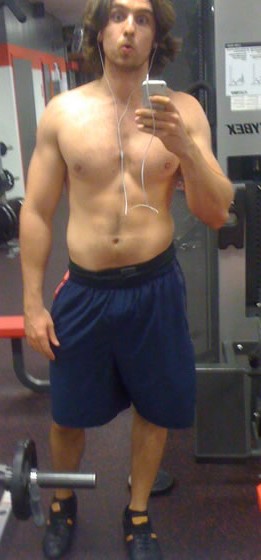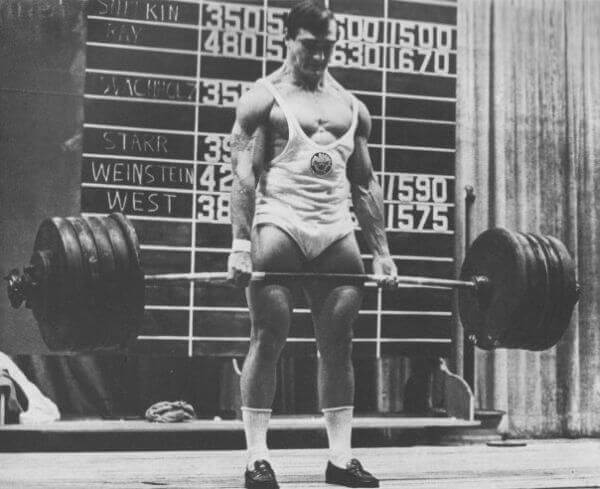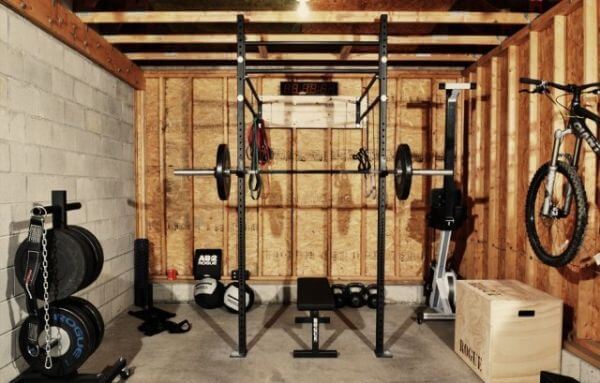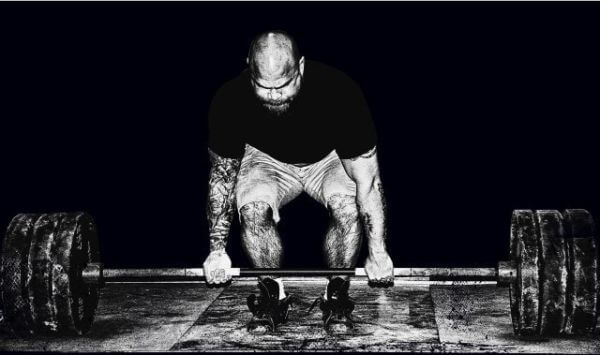Here’s a picture of me from several years ago:

I had been weightlifting for seven years and I wasn’t just fat–I was weak.
Like…pathetically weak.
- I weighed just over 200 pounds and I struggled to bench press more than 245 pounds…on the Smith Machine.
- I could half-squat about same for a few reps.
- I didn’t deadlift or military press frequently enough to even know my numbers.
My workouts were the garden variety crap languishing in bodybuilding magazines.
You know…tons of isolation exercises…tons of sets…tons of reps…and very little progress.
And then I found strength training.
I completely changed my workout routines and it completely changed my physique.
Here’s what 2.5 years of strength training got me:

(And yes, I learned how to diet as well along the way as well.)
As you can imagine, I never looked back.
Through my books and blogs, I’ve since helped hundreds of thousands of people start their own strength training journeys and personal transformations.
Well, in this article, I want to help you do the same.
We’re going to dive deep into strength training and learn how it works, how it differs from traditional bodybuilding training, and how to run the most popular strength training routines.
So if you’re ready to regularly hit personal bests and just generally feel like a superhero…and have a ton of fun while you’re at it…let’s get started.
Table of Contents
+The Benefits of Strength Training

I was 18 when I got into working out and my motivation was simple:
Girls like muscle and I like girls, so I needed muscle.
So began my quest for building bigger muscles, and I’ve since made a lot of mistakes and learned a lot of lessons.
One of the biggest mistakes I made was neglecting strength training.
Back when I didn’t know what I was doing, here was a typical chest workout of mine:
- Flat Smith Machine Press: 4 to 5 sets of 10 to 12 reps
- Flat Dumbbell Press: 4 to 5 sets of 10 to 12 reps
- Decline Bench Press: 4 to 5 sets of 10 to 12 reps, supersetted with push-ups to failure
- Dumbbell Flyes: 2 to 3 drop sets to failure
I would do workouts like this every day, grinding away for 1.5 to 2 hours, completely unaware that high-rep, “feel the burn” training should never be a natural weightlifter’s focus.
Instead, I should have been spending a lot less time in the gym, lifting a lot heavier weights, and doing a lot fewer exercises.
You see, like many people, I used to think that building strength didn’t necessarily relate to building muscle.
That is, I thought strength training was for getting strong but not necessarily big.
I was very wrong…
Strength Training and Muscle Growth

There are three primary ways to stimulate muscle growth:
- Progressive tension overload
- Muscle damage
- Cellular fatigue
Progressive tension overload is the most important of the three.
It refers to progressively increasing tension levels in the muscle fibers, and the most effective way to do this is to add weight to the bar over time.
Muscle damage refers to just that—microscopic damage caused to the muscle fibers by high levels of tension.
This damage necessitates repair, and if the body is provided with proper nutrition and rest, it will grow the muscle fibers to better deal with future stimuli.
Cellular fatigue refers to a host of intra- and extracellular changes that occur when muscle fibers contract repeatedly.
When you push muscle fibers to their metabolic limits through the repetition of actions to muscular failure, you’re causing high amounts of cellular fatigue.
Now, you can think of these three factors as separate muscle growth “pathways.” Each stimulate muscle growth but not equally.
They also relate to what scientists call the “strength-endurance continuum.”
- Heavy, low-rep weightlifting primarily builds strength and results in high amounts of muscle damage.
- Lighter, higher-rep weightlifting primarily increases muscle endurance and results in less muscle damage.
Few people will argue that high-rep, “pump” training builds strength equally as well as low-rep, high-weight training. Just look at all the best strength training programs out there: they involve a lot of heavy weightlifting.
What surprises many people, though–including me years ago–is that heavy strength training is also very effective for building muscle.
In fact, if you want to achieve your genetic potential for muscle growth, you’re going to have to do more and more strength training and less and less “bodybuilding” workouts.
“But wait a minute,” you might be thinking. “[SHREDDED FITNESS MODEL] does a billion reps in his workouts and has an amazing physique… What gives?”
If only you had his #dedication. All 2 grams of it that he injects every week.
I know, that might sound cynical, but it’s true.
When the right steroids enter the picture, achieving muscle growth is mind-numbingly simple:
Sit in the gym for a few hours every day doing rep after rep after rep, exercise after exercise, and muscles get bigger and bigger.
In fact, when steroids are involved, focusing on high-rep training is generally recommended.
Chemically enhanced muscles grow rapidly but don’t help tendons and ligaments keep up, so weights that feel manageable can simply be too much for connective tissues to handle.
This is a reason why steroid users often screw up their joints.
Anyway, when us “chemically challenged” folk do the same types of traditional bodybuilding routines–high-volume, high-rep training, with all the fancy drop sets, supersets, and the like–we just don’t see anywhere near the gains.
We’re inducing large amounts of cellular fatigue but, as you know, this is a weaker stimulus for growth than progressive overload. And this means very slow results.
To make matters worse, many bodybuilding routines involve more work with isolation exercises than compound movements.
This further reduces the amount of muscle you can build because the sheer amount of muscle fibers activated in a workout greatly affects overall muscle growth.
Want to Get Big? Then You Want to Get Strong

That’s the bottom line, really.
That isn’t to say that high-rep training has no place in a natural weightlifter’s routine, though.
It does…but it’s most relevant to experienced weightlifters and it never fully replaces the heavy lifting. I talk about this more here.
So, now that I’ve sufficiently whetted your appetite for hitting the heavy weights, let’s move on…
The Best Strength Training Workouts

If you’re used to high-rep, high-volume bodybuilding workouts, the transition to strength training is going to be a bit jarring at first.
- You’re going to press, pull, and squat some intimidatingly heavy weights.
- Depending on the program you follow, you’re probably going to train certain body parts more or less frequently.
- Your workouts may, on the whole, feel less draining.
- You’re going to be resting a lot more in between sets.
- Your workouts are probably going to be shorter.
Don’t be surprised if, soon after starting your strength training program, you find yourself wanting to do morein your workouts…taking shorter rest breaks…and increasing training and/or exercise frequency.
Well, don’t make these newbie mistakes.
What you don’t realize when you start strength training is how quickly systemic fatigue can build up if you try to do too much heavy training too fast.
That leads to overtraining, which can derail everything.
Remember…your number one goal in your strength training workouts is to get stronger, not maximize caloric burn or muscle pump or sweatiness.
This simple shift in mindset is going to help you tremendously.
Alright then, let’s move on.
Before you’ll be able to actually do any of the programs we’re going to discuss, you’re going to need to know a bit about how much weight you can actually lift on various exercises (your 5 rep maxes in particular).
So let’s knock that out now and then check out the programs.
Calculating How Much Weight You Can Lift

If you’re going to do a strength training program, you’re going to need to get comfortable working with various numbers and percentages.
As you’ll see, most programs revolve around your 5-rep max, or the amount of weight that you can get 5 clean reps with (and not more or less).
People that have spent a good amount of time pushing, pulling, and squatting heavy weights will know their numbers pretty accurately, but if you’re new to all this, just figuring out how much weight to use in your workouts can be frustrating.
Well, fear not, I have a calculator for you that makes it a snap (and yep, it will work for all the exercises you will be doing in your strength training programs).
Enter an amount of weight and reps that you know you can do and you’ll immediately see several sets of data:
- Your estimated one-rep max (how much you can lift for one rep).
- The weights at various percentages of that one-rep max.
- Approximately how much weight you should be able to use for various rep targets.
For example, if I can deadlift 415 for 4 reps, that puts my one rep max at ~453 pounds and my 3 rep max at 430, my 5 rep max at 390, my 8 rep max at 353, and so forth.
Again, the number you need most for the following programs is your 5-rep max.
The Best Strength Training Programs for Newbies

If you’re new to strength training or heavy barbell training in general, I recommend you start with one of the following programs.
Starting Strength

Starting Strength is one of the most popular weightlifting programs out there, and for good reason.
Written by Mark Rippetoe and first published in 2005, and now in its third edition, the eponymous book has become a staple of bodybuilding literature.
If you’re serious about weightlifting, then you want to read Starting Strength. Even if you don’t plan on following the program.
The reason Starting Strength is so attractive to so many people–and especially to people new to weightlifting–is it’s simple, effective, and suited to a wide variety of goals.
- If you want to get strong…Starting Strength can help.
- If you want to add muscle…Starting Strength can do that too.
- If you want to improve athleticism…Starting Strength will get the job done.
The bottom line is if you’re new to heavy barbell training or strength training in general, you can’t go wrong starting with Starting Strength.
The Starting Strength Routine

Starting Strength workouts are very simple. They rely on a handful of compound exercises and the focus of the program is achieving the biggest possible lifts by the end of it.
Before we get into the routine, though, I highly recommend you check out the book to learn proper form on the exercises you will be doing.
They aren’t inherently dangerous but if you don’t know what you’re doing, you can get hurt.
Now, let’s talk basics.
You alternate between two workouts.
Unlike “muscle confusion” workout routines, Starting Strength has you do just two workouts.
| WORKOUT A | ||
| EXERCISE | SETS | REPS |
| Squat | 3 | 5 |
| Overhead Barbell Press | 3 | 5 |
| Deadlift | 1 | 5 |
| WORKOUT B | ||
| EXERCISE | SETS | REPS |
| Squat | 3 | 5 |
| Bench Press | 3 | 5 |
| Deadlift | 1 | 5 |
No, I’m not forgetting anything.
There are only four exercises for your first Starting Strength workouts and only six in the whole program.
You do 3 workouts per week.
Here’s how your first month works:
| WEEK 1 | |
| DAY | WORKOUT |
| 1 | A |
| 2 | Rest |
| 3 | B |
| 4 | Rest |
| 5 | A |
| 6 | Rest |
| 7 | Rest |
| WEEK 2 | |
| DAY | WORKOUT |
| 1 | B |
| 2 | Rest |
| 3 | A |
| 4 | Rest |
| 5 | B |
| 6 | Rest |
| 7 | Rest |
| WEEK 3 | |
| DAY | WORKOUT |
| 1 | A |
| 2 | Rest |
| 3 | B |
| 4 | Rest |
| 5 | A |
| 6 | Rest |
| 7 | Rest |
| WEEK 4 | |
| DAY | WORKOUT |
| 1 | B |
| 2 | Rest |
| 3 | A |
| 4 | Rest |
| 5 | B |
| 6 | Rest |
| 7 | Rest |
You start each exercise in your workouts workout with warm-up sets.
Warm-up sets get your muscles and connective tissues ready for the heavy lifting ahead.
You do your first warm-up set with the empty bar and then evenly progress up to your working weight over the course of several additional sets.
For example, if you can squat 275 pounds for 5 reps, your warm-up routine would look like this:
Empty Bar (45 pounds)
2 sets of 5 reps
135 Pounds
2 sets of 5 reps
185 Pounds
1 set of 3 reps
235 Pounds
1 set of 2 reps
275 Pounds (Working Sets)
3 sets of 5 reps
If that sounds complicated to you, you can always use this handy little app.
After you’re warmed up, you get to your heavy lifting.
How much weight to use for your heavy sets.
Your heavy sets should be done with an amount of weight that allows you to get 5 reps with good form (and not more or less).
If you’re new to heavy weightlifting, it’s a good idea to start with a weight slightly lower than your calculated 5-rep max and progress upward as you get comfortable.
Rest times in between sets.
Rest 2 to 5 minutes in between sets. When you go to do your next set, you shouldn’t be breathing heavy or feel fatigued from your previous one.
When and how to add weight to the bar.
If you successfully perform your 3 sets of 5 reps in a workout, you add 5 pounds to the weight the next time you that exercise.
So, for instance, if you successfully squat 200 pounds for 5 reps in Workout A, you squat 205 pounds in Workout B.
What to do if you fail to get your reps.
If you’re not able to get your sets–if you get, let’s say, 5, 4, and 3 reps–then you stick with that current weight until you can get 5,5,5.
If you can get 5 reps on your first set but can only get 2 or 3 reps on your second and third sets, the weight is too high.
When you reach a point where you haven’t been able to increase weight for two workouts in a row, it’s time to reset on both workouts. You do this by doing your warm ups and then doing 1 set at 90% of your best 5-rep lift for each exercise.
If you want to know more about Starting Strength…
That’s enough to get you going on the program but if you’re going to stick with it, make sure you read the book.
5 x 5

In 1976, a book was released that changed strength training sports forever.
It was called The Strongest Shall Survive: Strength Training for Football and its philosophy was very simple.
To quote the book’s author, the legendary Olympian and strength coach Bill Starr:
“The football player (and you can insert Martial Artist, Fighter, whatever there) must work for overall body strength as opposed to specific strengthening exercise.
“In other words the athlete should be building total leg strength rather than just stronger hamstrings. He should be seeking overall strength in his shoulder girdle rather than just stronger deltoids.”
Accordingly, Starr’s 5 x 5 program shared in the book focused on three lifts: the bench press, squat, and power clean.
Here’s the original program:
| MONDAY (HEAVY) | ||
| EXERCISE | SETS | REPS |
| Power Clean | 5 | 5 |
| Bench Press | 5 | 5 |
| Bench Press | 1 | 10 |
| Squat | 5 | 5 |
| Squat | 1 | 10 |
| WEDNESDAY (LIGHT) | ||
| EXERCISE | SETS | REPS |
| Power Clean | 5 | 5 |
| Incline Bench Press | 5 | 5 |
| Incline Bench Press | 1 | 10 |
| Squat | 5 | 5 |
| FRIDAY (MEDIUM) | ||
| EXERCISE | SETS | REPS |
| Power Clean | 5 | 5 |
| Overhead Press | 5 | 5 |
| Overhead Press | 1 | 10 |
| Squat | 5 | 5 |
Ramping up the weights.
With each exercise in each workout, your sets start light and get progressively heavier and the amount of weight you lift varies from day to day.
Here’s how the Heavy Day works:
- Set 1 is 35% of your 5-rep-max weight (the amount of weight that allows you to get 5 clean reps but no more).
- Set 2 is 70% of your 5-rep-max weight.
- Set 3 is 80% of your 5-rep-max weight.
- Set 4 is 90% of your 5-rep-max weight.
- Set 5 is 100% of your 5-rep-max weight.
- 10-rep set is 80% of your 5-rep-max weight.
Here’s how the Light Day works:
- Set 1 is 25% of your 5-rep-max weight.
- Set 2 is 50% of your 5-rep-max weight.
- Set 3 is 55% of your 5-rep-max weight.
- Set 4 is 65% of your 5-rep-max weight.
- Set 5 is 70% of your 5-rep-max weight.
- 10-rep set is 55% of your 5-rep-max weight.
And here’s how the Medium Day works:
- Set 1 is 30% of your 5-rep-max weight.
- Set 2 is 55% of your 5-rep-max weight.
- Set 3 is 65% of your 5-rep-max weight.
- Set 4 is 70% of your 5-rep-max weight.
- Set 5 is 80% of your 5-rep-max weight.
- 10-rep set is 65% of your 5-rep-max weight.
When and how to add weight to the bar.
Starr recommended that you increase your 5-rep-maxes on each exercise by 2.5% each week.
For example, if you start the program and your 5 rep max on the bench press is 225 pounds, here’s how it would play out…
Week 1
Here’s how your bench pressing on your Heavy Day would look:
| BENCH PRESS (HEAVY DAY) | ||
| SET | % OF 5RM | POUNDS |
| 1 | 35% | 80 |
| 2 | 70% | 160 |
| 3 | 80% | 180 |
| 4 | 90% | 200 |
| 5 | 100% | 225 |
| 10-REP | 80% | 180 |
To make it work for actual bar loading, round numbers up or down by 1 pound (or less). Technically 35% of 225 is 79 pounds but loading 79 pounds on the bar isn’t feasible–you’re going to use 80.
And the rest of the exercises are laid out in the same fashion.
Week 2
You now increase the previous week’s 5-rep-max weights by 2.5%.
Sticking with just the bench press for an example, your previous 5 rep max of 225 pounds is now raised to 230.
And here’s how your bench pressing in the same workout given above now looks:
| BENCH PRESS (HEAVY DAY) | ||
| SET | % OF 5RM | POUNDS |
| 1 | 35% | 80 |
| 2 | 70% | 160 |
| 3 | 80% | 185 |
| 4 | 90% | 205 |
| 5 | 100% | 230 |
Due to the small increase in your 5-rep-max weight, sets 1 and 2 stay the same, and in this case, set 3 is rounded up from 184 to 185 and set 4 is rounded down to 205 from 207.
Week 3
In week 3, you increase your new 5 rep maxes by 2.5%, and so forth.
Rest times in between sets.
Like Starting Strength, rest 2 to 5 minutes in between sets.
What to do if you fail to get your reps.
If you fail to get your reps on a given exercise, Starr recommends resetting or deloading.
Resetting consists of lowering the weights to what you were doing 4 weeks ago.
Deloading is explained here.
If you want to learn more about the 5 x 5 program…
The best way to learn more about 5 x 5 is just picking up Starr’s book
Stronglifts 5 x 5

Stronglifts 5 x 5 is a variation of Starr’s original routine that was created by…a dude…named Mehdi.
It’s simple, effective, and doesn’t require you spend large amounts of time in the gym.
You alternate between two workouts.
Like Starting Strength, Stronglifts consists of two workouts that you alternate between.
| WORKOUT A | ||
| EXERCISE | SETS | REPS |
| Squat | 5 | 5 |
| Bench Press | 5 | 5 |
| Barbell Row | 5 | 5 |
| WORKOUT B | ||
| EXERCISE | SETS | REPS |
| Squat | 5 | 5 |
| Overhead Press | 5 | 5 |
| Deadlift | 1 | 5 |
You do 3 workouts per week.
You train three times per week, with at least one day of rest in between workouts.
Most people work out on Mondays, Wednesdays, and Fridays, but so long as you give your body one day in between each workout, you can change the schedule (Tues, Thurs, Saturday or Sunday, for example).
You alternate between these workouts in the same way as Starting Strength.
Week 1 is A, B, A, week 2 is B, A, B, week 3 is the same as week 1, week 4 is the same as week 2, and so forth.
How to warm up.
Here’s how Mehdi explains the warm-up procedure:
Start with two sets of five reps with the empty bar on Squats, Bench and Overhead Press. Then add 10-20kg (25-45lb) and do 2-3 reps. Keep adding 10-20kg, doing 2-3 reps on each set, until you’ve reached your 5×5 weight. Don’t rest between these warmup sets to keep your workout short.
Empty bar warmup sets don’t work for Barbell Row and Deadlift. The bar has to start at mid-shin level for proper form, you can’t hold it in the air. Plus, since you’re doing compound exercises, your whole body is warmed up already by the time you have to Barbell Row or Deadlift. So you can start heavier here.
Never do a heavy 5×5 weight without doing lighter warmup sets first. The 5×5 weight will feel heavier, you can miss reps and could get hurt. Start with the bar and work your way up so you warmup your muscles and can practice proper form. This will make the 5×5 weight easier and you’re less likely to get hurt.
Cardio pre-workout is not enough and can work against you. It’s not specific to Squatting, doesn’t let you practice proper form. So you still have to warmup with the bar. Worse, too much cardio pre-workout will pre-exhaust your legs and make it hard to Squat heavy. So warm up with the bar.
Once you’re warmed up, you’re ready to do your heavy, 5-rep sets. Each set should be done with 100% of your 5-rep-max weights (you don’t progress to 100% like Starr’s program).
When and how to add weight to the bar.
Progression is simple and linear: you add 5 pounds to each exercise each time you do it.
And yes, that means adding 15 pounds to your squat each week, which is very aggressive, but doable for someone new to weightlifting.
If you’re an experienced weightlifter, however, you know that adding 15 pounds per week is impossible.
Rest times in between sets.
You rest 2 to 5 minutes in between each set.
What to do if you fail to get your reps.
Mehdi recommends that you deload if you stall.
If you’d like to know more about Stronglifts 5 x 5…
If you’d like to know more, you can dive into the details here.
The Best Strength Training Programs for Intermediate Lifters

If you’ve been following a strength training program or have been doing heavy barbell training (like one of my programs) for at least a year, then you’ll do best on one of the following programs.
Texas Method

The Texas Method is a hugely popular strength training program and is particularly suited to intermediate lifters.
It was developed kind of accidentally by the esteemed Olympic weightlifting coach Glenn Pendlay , and it’s more of a training template than a fixed routine.
Let’s look it over.
You do 3 workouts per week.
Like all the strength training programs we’ve covered so far, the Texas Method involves training three times per week.
Mondays are for volume, Wednesdays are light, and Fridays are very heavy (where you go for PRs).
For example, here’s a well-rounded Texas Method workout routine that many people follow:
Week A
| MONDAY (VOLUME) | |||
| EXERCISE | SETS | REPS | % OF 5RM |
| Squat | 5 | 5 | 90 |
| Bench Press | 5 | 5 | 90 |
| Deadlift | 1 | 5 | 90 |
| WEDNESDAY (LIGHT) | |||
| EXERCISE | SETS | REPS | % OF 5RM |
| Squat | 2 | 5 | 70 |
| Overhead Press | 3 | 5 | 70 |
| Chin-Up | 3 | Fail | Bodyweight |
| Hyperextension | 5 | 10 | N/A |
| FRIDAY (INTENSITY) | |||
| EXERCISE | SETS | REPS | % OF 5RM |
| Squat | 1 | 5 | PR |
| Bench Press | 1 | 5 | PR |
| Deadlift | 1 | 5 | PR |
Week B
| MONDAY (VOLUME) | |||
| EXERCISE | SETS | REPS | % OF 5RM |
| Squat | 5 | 5 | 90 |
| Overhead Press | 5 | 5 | 90 |
| Deadlift | 1 | 5 | 90 |
| WEDNESDAY (LIGHT) | |||
| EXERCISE | SETS | REPS | % OF 5RM |
| Squat | 2 | 5 | 70 |
| Bench Press | 3 | 5 | 70 |
| Chin-Up | 3 | Fail | Bodyweight |
| Hyperextension | 5 | 10 | N/A |
| FRIDAY (INTENSITY) | |||
| EXERCISE | SETS | REPS | % OF 5RM |
| Squat | 1 | 5 | PR |
| Overhead Press | 1 | 5 | PR |
| Deadlift | 1 | 5 | PR |
You alternate between weeks A and B, giving you a chance to repeatedly PR both your bench and overhead press.
Now, as you can see, the Volume and Light Days are pretty straightforward. Before each exercise, you warm up (which we’ll talk more about in a minute) and then do your prescribed sets.
Fridays are personal record (PR) days–days where you dig deep to lift highest-ever weights.
Specifically, you start each exercise with a warmup routine and then do your one 5-rep PR set, which should be 5 to 10 pounds heavier than your previous 5 rep max.
For example, if your predicted 5 rep max for the squat is 275, then on Friday you will go for 5 reps with 280 or 285 pounds.
How to warm up.
You can use the same warm-up routine as Starting Strength:
You do your first warm-up set with the empty bar and then evenly progress up to your working weight over the course of several additional sets.
For example, if you can squat 275 pounds for 5 reps, your warm-up routine would look like this:
Empty Bar (45 pounds)
2 sets of 5 reps
135 Pounds
2 sets of 5 reps
185 Pounds
1 set of 3 reps
235 Pounds
1 set of 2 reps
275 Pounds (Working Sets)
3 sets of 5 reps
If that sounds complicated to you, you can always use this handy little app.
When and how to add weight to the bar.
The goal with the Texas Method isn’t workout-to-workout progress–it’s weekly progress.
And progression is very simple: you add 5 pounds to each Friday’s single 5-rep set.
This gives you a new 5 rep max with which you calculate your next week’s Monday and Wednesday workouts, and Friday is PR day again.
In this way the weights you lift in every workout move up over time.
Rest times in between sets.
Like Starting Strength, rest 2 to 5 minutes in between sets.
What to do if you fail to get your reps.
If you’re unable to get through Monday’s workout (you can’t get all of your reps with good form), it’s recommended that you cut down the volume on your Mondays to 3 sets of 5 with 90% of your 5-rep max on your squats and bench presses or reduce the load by 10%, to 80% of your 5-rep max. The bottom line is you need more recovery.
If you can get through Monday’s workout but can’t hit your PRs on Friday, it’s recommended that you change your Monday workout by increasing volume (total number of reps) or intensity (amount of weight lifted).
For example, increasing volume is simple: instead of doing 5 sets of 5 reps with 90% of your 5-rep max on your first two exercises, you might do 5 sets of 8 reps with 80%.
When you’re increasing load, you want to keep your volume the same. When you squat 5 sets of 5 reps with 90% of your 5-rep max, that’s 25 reps. You could increase this load by squatting 8 sets of 3 reps (24 reps) with 95%.
If you’d like to know more about Texas Method…
As you can tell, there are quite a few moving parts to the Texas Method–far too many to dive into in this primer.
If you give it a go and like it, or like the structure and concepts but want to learn more before implementing it, read Practical Programming for Strength Training by Mark Rippetoe.
Wendler’s 5/3/1
Jim Wender’s “5/3/1” program is one of the most popular strength programs out there because it’s easy to understand, it gets results, it doesn’t require any special equipment, and the workouts are relatively short.
Here’s how it works.
You do 3 to 4 workouts per week.
5/3/1 has you do one of four workouts on your training days:
Squat and assistance work.
Bench Press and assistance work.
Deadlift and assistance work.
Overhead Press and assistance work.
You perform each of these workouts once to complete what is called a “wave.”
Here’s how it’s commonly laid out:
| DAY 1 | DAY 2 |
| Warm-Up | Warm-Up |
| Overhead Press | Deadlift |
| Assistance Work | Assistance Work |
| DAY 3 | DAY 4 |
| Warm-Up | Warm-Up |
| Bench Press | Squat |
| Assistance Work | Assistance Work |
Each “mesocycle” (a fancy term for a training phase that lasts 2 to 6 weeks) of 5/3/1 consists of four waves.
That is, you will do each of the workouts 4 times to complete a mesocycle, at which point you start over again from the beginning.
Here’s how the mesocycle works:
| WAVE 1 | ||
| SET | % OF 90% OF 1RM | REPS |
| 1 | 65% | 5 |
| 2 | 75% | 5 |
| 3 | 85% | 5+ |
| WAVE 2 | ||
| SET | % OF 90% OF 1RM | REPS |
| 1 | 70% | 3 |
| 2 | 80% | 3 |
| 3 | 90% | 3+ |
| WAVE 3 | ||
| SET | % OF 90% OF 1RM | REPS |
| 1 | 75% | 5 |
| 2 | 85% | 3 |
| 3 | 95% | 1+ |
| WAVE 4 | ||
| SET | % OF 90% OF 1RM | REPS |
| 1 | 40% | 5 |
| 2 | 50% | 5 |
| 3 | 60% | 5 |
Note that 5/3/1 works with a percentage of 90% of your one-rep max, not a percentage of your 5-rep max like other strength programs.
Also, the sets with + sign indicate that you should get as many reps as you can.
Yup, each workout entails just warming up and doing 3 heavy sets.
This low-volume approach is one of the common critiques of the 5/3/1 program but there’s no denying that it works.
It just isn’t for everyone. If you have years of strength training under your belt, 5/3/1 probably isn’t the right choice for you–but you already know that. If you’re new to strength training, though, you can do great with this simple approach.
This is especially true if you include enough assistance work in addition to the core lifts. This allows you to create a hybrid style of training that has strength training at its core and accessorizes with bodybuilding “beach work,” as Bill Starr used to call it.
This, in fact, is the basic idea behind my Bigger Leaner Stronger (for men) and Thinner Leaner Stronger (for women) programs. They’re basic strength training programs with additional work meant more for building a physique than building maximum power.
Now, your training frequency will determine how to program your workouts.
If you train 4 times per week, each mesocycle will last 4 weeks. If you train 3 times per week, they will last 5 weeks and 1 day (you’ll see why in a moment).
Here’s how to program your workouts if you’re training 4 days per week:
| WEEK 1 | ||
| DAY | EXERCISE | WAVE |
| 1 | Overhead Press | 1 |
| 2 | Deadlift | 1 |
| 3 | Bench Press | 1 |
| 4 | Squat | 1 |
| WEEK 2 | ||
| DAY | EXERCISE | WAVE |
| 1 | Overhead Press | 2 |
| 2 | Deadlift | 2 |
| 3 | Bench Press | 2 |
| 4 | Squat | 2 |
| WEEK 3 | ||
| DAY | EXERCISE | WAVE |
| 1 | Overhead Press | 3 |
| 2 | Deadlift | 3 |
| 3 | Bench Press | 3 |
| 4 | Squat | 3 |
| WEEK 4 | ||
| DAY | EXERCISE | WAVE |
| 1 | Overhead Press | 4 |
| 2 | Deadlift | 4 |
| 3 | Bench Press | 4 |
| 4 | Squat | 4 |
And if you train 3 days per week, it takes 5 weeks and 1 day because you still have to do all 16 workouts to complete the mesocycle and you can’t double up exercises on a training day.
Here’s a simple way to program it:
| WEEK 1 | ||
| DAY | EXERCISE | WAVE |
| 1 | Squat | 1 |
| 2 | Bench Press | 1 |
| 3 | Deadlift | 1 |
| WEEK 2 | ||
| DAY | EXERCISE | WAVE |
| 1 | Overhead Press | 1 |
| 2 | Squat | 2 |
| 3 | Bench Press | 2 |
| WEEK 3 | ||
| DAY | EXERCISE | WAVE |
| 1 | Deadlift | 2 |
| 2 | Overhead Press | 2 |
| 3 | Squat | 3 |
| WEEK 4 | ||
| DAY | EXERCISE | WAVE |
| 1 | Bench Press | 3 |
| 2 | Deadlift | 3 |
| 3 | Overhead Press | 3 |
| WEEK 5 | ||
| DAY | EXERCISE | WAVE |
| 1 | Squat | 4 |
| 2 | Bench Press | 4 |
| 3 | Deadlift | 4 |
| WEEK 6 | ||
| DAY | EXERCISE | WAVE |
| 1 | Overhead Press | 4 |
| 2 | Rest | |
| 3 | Rest | |
As you can see, both the 4- and 3-day splits have you performing each of the workouts 4 times before restarting.
How to warm up.
Here’s how you should warm up for your heavy lifting:
Warm-Up Set #1
40% of your 1RM x 5 reps
Warm-Up Set #2
50% of your 1RM x 5 reps
Warm-Up Set #3
60% of your 1RM x 3 reps
You rest for 60 to 90 seconds in between each warm-up set.
When and how to add weight to the bar.
Your goal isn’t just to break your on-rep PRs–it’s to hit multiple PRs along the way by lifting more in each workout than your previous mesocycle.
So, once you’ve completed a mesocycle, you should add 5 pounds to your one-rep max for your bench and overhead press and 10 pounds to your squat and deadlift and recalculate your training weights.
Furthermore, if you feel you can get more reps on your final, hardest sets, Wendler recommends you go for it.
Rest times in between sets.
Like Starting Strength, rest 2 to 5 minutes in between sets.
What to do if you fail to get your reps.
If you get stuck or even lose strength on an exercise or exercises, finish your mesocycle and then reduce your current 1RMs by 10% and start again.
You only need to do this on the exercise(s) you’re struggling with. Continue as usual on the others.
How to choose your assistance exercises.
“Assistance work” refers to exercises done other than the four the program is built around. How much assistance work you do is up to you, but it’s done for one or more of the following reasons:
- Strengthen weak parts of the body
- Help increase the four core lifts
- Ensure your body develops in a balanced and symmetrical fashion
- Build more muscle
If you’re familiar with my Bigger Leaner Stronger program, you’ll feel right at home with almost every assistance exercises that Wendler recommends:
- Dips, weighted if possible
- Chin-ups or pull-ups
- Dumbbell Rows
- Barbell Rows
- Barbell Shrugs
- Dumbbell Bench Press
- Dumbbell Military Press
- Lunge
- Leg Press
In fact, Wendler’s recommendations are so similar to my list of “approved exercises” in Bigger Leaner Stronger that you can just use it as a guide.
In terms of programming your workouts, the most popular assistance routine is one Wendler calls “Boring But Big.”
It has you do the core, heavy lifts and then 5 sets of 10 reps with the same exercise followed by another assistance exercise for 5 sets of 10 reps.
For example, your squat day might go like this:
- Squat – Core sets
- Squat – 5 sets of 10 reps
- Lunge – 5 sets of 10 reps
In terms of how much weight you should use for the 10-rep sets, Wendler recommends that you start with light weights—40-50% of your 1RM—and gradually work up from there.
How high you ultimately go is up to you, but I would recommend working up to using an amount of weight that allows for at least 8, but no more than 10 reps.
If you’d like to know more about 5/3/1…
Wendler gives several other assistance routines as well as advice on how to program them properly in his book, aptly titled 5/3/1, which I highly recommend you read if you’re going to do his program.
It’s a great read, you’ll learn more about the ins and outs of the system, and you’ll support his work.
The Bottom Line on Strength Training

I used to think strength training was just for powerlifters.
I was wrong–it’s for everyone.
In fact, strength training is a far more effective (and time efficient) way to build a strong, muscular, and lean physique than the traditional bodybuilding routines that
focus on high-rep, high-volume workouts and isolation exercises.
It’s also a lot more fun. 🙂
What’s your take on strength training? Have anything else to share? Let me know in the comments below!
Scientific References +
- Burd, N. A., Mitchell, C. J., Churchward-Venne, T. A., & Phillips, S. M. (2012). Bigger weights may not beget bigger muscles: Evidence from acute muscle protein synthetic responses after resistance exercise. Applied Physiology, Nutrition and Metabolism, 37(3), 551–554. https://doi.org/10.1139/H2012-022
- Schoenfeld, B. J., Ratamess, N. A., Peterson, M. D., Contreras, B., Sonmez, G. T., & Alvar, B. A. (2014). Effects of different volume-equated resistance training loading strategies on muscular adaptations in well-trained men. Journal of Strength and Conditioning Research, 28(10), 2909–2918. https://doi.org/10.1519/JSC.0000000000000480
- Campos, G. E. R., Luecke, T. J., Wendeln, H. K., Toma, K., Hagerman, F. C., Murray, T. F., Ragg, K. E., Ratamess, N. A., Kraemer, W. J., & Staron, R. S. (2002). Muscular adaptations in response to three different resistance-training regimens: Specificity of repetition maximum training zones. European Journal of Applied Physiology, 88(1–2), 50–60. https://doi.org/10.1007/s00421-002-0681-6
- Allen, D. G., Lamb, G. D., & Westerblad, H. (2008). Skeletal muscle fatigue: Cellular mechanisms. In Physiological Reviews (Vol. 88, Issue 1, pp. 287–332). Physiol Rev. https://doi.org/10.1152/physrev.00015.2007
- A L Goldberg, J D Etlinger, D F Goldspink, C. J. (n.d.). Mechanism of work-induced hypertrophy of skeletal muscle - PubMed. Retrieved July 15, 2020, from https://pubmed.ncbi.nlm.nih.gov/128681/
- Schoenfeld, B. J. (2010). The mechanisms of muscle hypertrophy and their application to resistance training. In Journal of Strength and Conditioning Research (Vol. 24, Issue 10, pp. 2857–2872). J Strength Cond Res. https://doi.org/10.1519/JSC.0b013e3181e840f3











